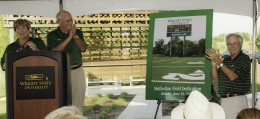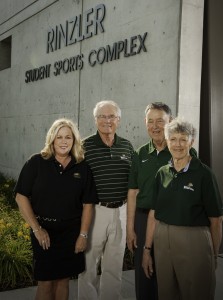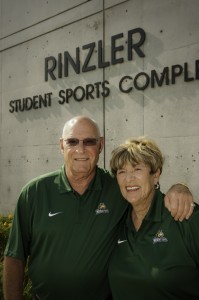Wright State’s northeast corner of campus has undergone a major facelift in the last year. At the center of the project is the new Rinzler Student Sports Complex.
About 200 people–including donor and namesake Allan Rinzler, Wright State President David R. Hopkins and former Wright State president Paige E. Mulhollan–attended the special June 18 dedication ceremony.
“This has been a dream and a goal I’ve always had for the students of Wright State—to give all Wright State students the access to a state-of-the-art sports complex like this,” said Rinzler.
The Rinzler Student Sports Complex is designed to be a hub for Raider athletics as well as all other students through campus recreation.
At the dedication ceremony, Hopkins also revealed that the new multipurpose turf field will be named Mulhollan Field, after Wright State’s third president.

Wright State President David R. Hopkins revealed at the dedication that the multipurpose turf field will be named Mulhollan Field.
“It’s so wonderful because Dr. Mulhollan did so much for the university,” said Hopkins. “The Wright State Nutter Center is here because of him, the Dolores and Fritz Russ Engineering Center is here because of his efforts and the Student Union is here because of the great work he did, not to mention all of the academic programs.”
Students, staff and faculty have been playing and practicing on the new synthetic turf for months, which Athletic Director Bob Grant called the best intercollegiate soccer surface in Ohio.
“I can’t tell you how much we appreciate this gift and this facility. This playing surface out here and the facility next to it really sets us apart from virtually all of our competition in men’s and women’s soccer,” said Grant.

Wright State President David R. Hopkins and his wife Angelia (left) with Wright State’s third president, Paige E. Mulhollan and his wife Mary Bess.
The complex includes a new support building with restrooms, team rooms and concessions. In addition to the new synthetic turf at the varsity soccer field, synthetic turf for a new student recreation field was also installed, as well as lighting for the varsity women’s softball field.
A sleek observation ramp provides an easy, accessible perch to watch events and games. But most of all, it gives students the chance to have a more well-rounded collegiate education.
“When you’re trying to prepare people to be successful in the future, it’s a lot about academics, but not entirely,” said Hopkins. “We’re trying to teach about leadership, working in teams, creating environments where students understand how to work with all kinds of people, so recreational facilities like these really add a special feature to college education.”


 Bags, boards and bonding
Bags, boards and bonding  More than 1,000 students to graduate at Wright State’s fall commencement ceremonies
More than 1,000 students to graduate at Wright State’s fall commencement ceremonies  Wright State’s Take Flight Program helps students soar high
Wright State’s Take Flight Program helps students soar high  Wright State Police Department delivers major donation to Raider Food Pantry
Wright State Police Department delivers major donation to Raider Food Pantry  Wright State engineering and computer science students earn prestigious federal SMART Scholarships
Wright State engineering and computer science students earn prestigious federal SMART Scholarships 